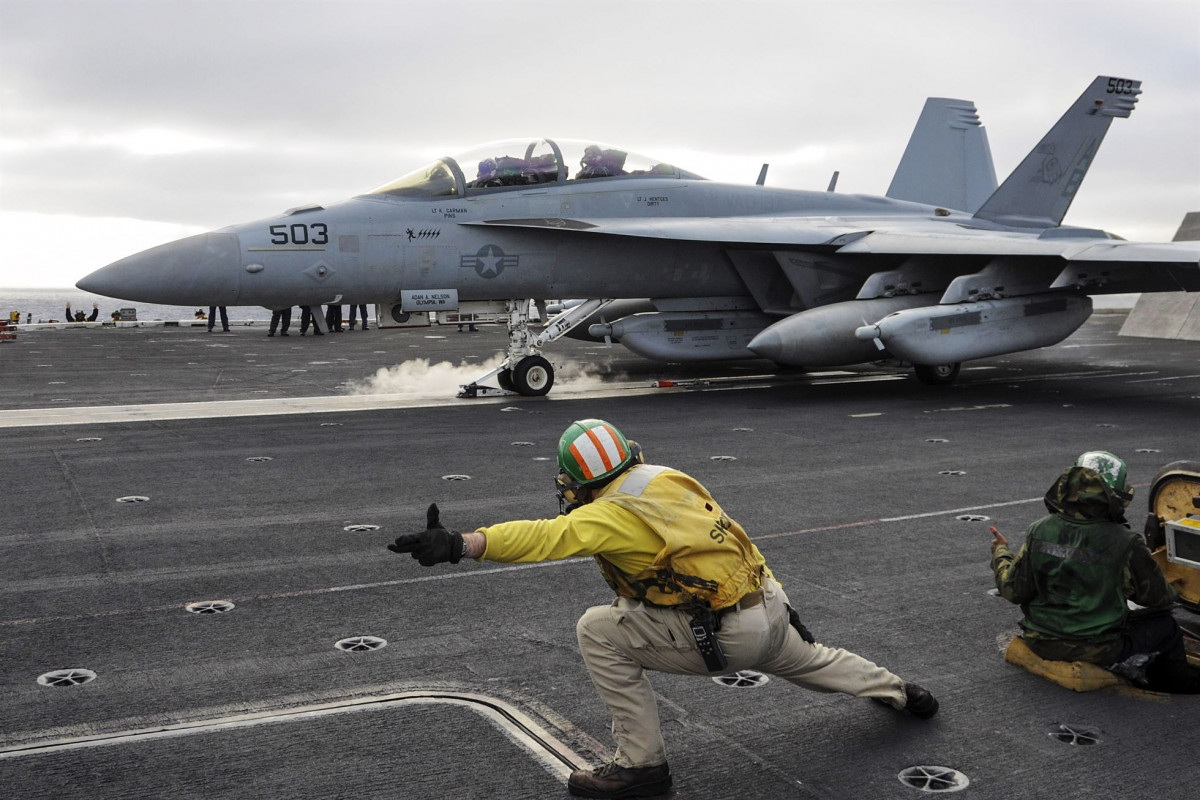
Shoni Fuqua
The EA-18G Growler “is the most advanced airborne electronic attack (AEA) platform and is the only one in production today…..The Growler provides tactical jamming and electronic protection to U.S. military forces and allies around the world” (Boeing 2008). Jamming is “detecting, sorting, and identifying certain electronic signals among the deluge of existing signal clutter and determining appropriate actions against signals of interest” (CNIC 2019).
The Growlers are stationed at Naval Air Station Whidbey Island (NASWI) in Washington state. According to former head of the Washington National Guard Tim Lowenberg, the Growler jets are here because of the state’s geographical location, “We are hours closer by air and days closer by sea for getting to places throughout the Pacific” (Christensen 2016).
Growlers are the loudest planes in the world. The Navy bases them at Ault Field, near the northern end of Whidbey Island. Ault Field is the primary airfield utilized by the Navy in the Pacific Northwest. Listen to this video of Growlers over the Cornet Bay Retreat Center near Deception Pass, at the northern tip of the island.
NASWI also uses the island to practice Field Carrier Landing Practices (FCLP), or simulations of the jets landing and taking off from aircraft carriers. These “touch-and-go” landings are conducted at the Out-Lying Field (OLF) near Coupeville in central Whidbey Island. Because the landings and take-offs are in close sequence, the exercises are particularly noisy to residents of the area. The site is near Ebey’s Landing National Historic Reserve, a unique federal site preserving the island’s rural agricultural heritage (National Park Service 2019).
The OLF is three miles from Coupeville, a hospital, Recycling Center, Transit Center, 800 children in three schools, and 400 homes in Admiral’s Cove. This places many of them within Accident Potential Zones (APZs), or areas along the flight paths that extend a certain distance beyond the Clear Zone; all of the paths and zones are designated by the military.
Growler Jets
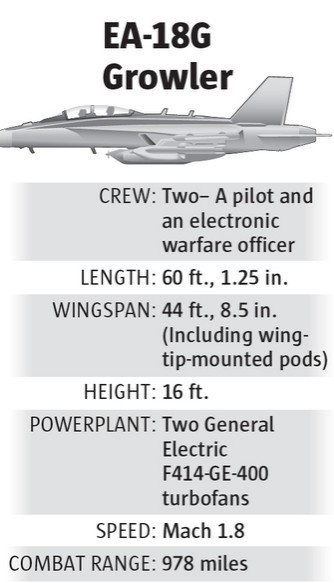
According to the Commander, Navy Installations Command (CNIC), the U.S. Navy followed all legal obligations transitioning from Prowler jets to the much louder Growler jets. The Environmental Assessment (EA) completed by the Navy in 2005 determined no significant environmental effects and did not require an Environmental Impact Statement. “The 2005 EA analyzed 57 Growler aircraft replacing 72 Prowler aircraft, which included disestablishment of three Expeditionary Squadrons (or the loss of 15 aircraft which deploy to land bases worldwide). After an extensive review, the Navy determined that there was no significant impact of transitioning Prowlers to Growlers for nine carrier squadrons which deploy on aircraft carriers. In October 2009, the Defense Department directed the Navy to keep the Expeditionary squadrons indefinitely. Therefore, the Navy prepared the 2012 EA which analyzed retaining the three Expeditionary Squadrons and relocating a Reserve squadron to NASWI. The 2012 EA considered the potential cumulative impacts of the earlier 2005 action. After an extensive review, the Navy determined that there was no significant impact of keeping three expeditionary squadrons and relocating a reserve squadron. Considering the changes proposed and analyzed in the 2005 EA and 2012 EA, the 72 legacy Prowlers were ultimately replaced with 82 Growlers, an overall increase of 10 aircraft to support both the Carrier and Expeditionary missions” (CNIC n.d.).
Growler Expansion Proposal
The Navy proposes that Growlers should be used in Electromagnetic War Games over the Olympia Peninsula (see EMR War Games), and so their numbers should be expanded at NASWI. The Navy originally was supposed to be limited to 6,120 flights a year by 2013. To the contrary, the Navy increased flights in 2011 to 9,378 and 9,668 in 2012. The Navy is adding 36 more Growlers to the fleet for a total of 118. Each Growler cost $80.5 Million and the program cost $13. 8 Billion. In 2018 there were 6,200 takeoffs and landings at OLF Coupeville which will expand to 24,000; the military originally proposed 36,000 flights. At Ault Field there were 75,000 flights in 2017 and 88,000 in 2018 (Wilkinson 2018).
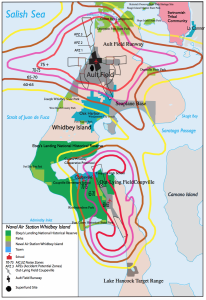
Effects of noise pollution
Noise pollution has serious health effects on the environment, wildlife, and human health along jet flight paths. Some documented effects are sleep disturbance, hearing loss, immune toxicity, cardiac disease, hypertension, myocardial infarction, heart attacks, and strokes.
The EA-18G Growler is much louder than its predecessor, the EA-6B Prowler it replaced. According to the CNIC, “The noise study conducted for the 2012 EA does acknowledge that the Growler is 1 decibel louder during arrival than the Prowler, but the Growler is also 2-8 decibels quieter in other flight profiles. Generally, a change of less than 3 decibels is not perceptible. Noise exposure varies depending on where you are in relation to the flight path” (CNIC n.d.). As noted in the 2012 Final Environmental Assessment, the Growler has a “slightly higher potential to cause noise-induced vibrations. The Growler is recognizable by the low frequency ‘rumble’ of its jet engines, whereas the Prowler is associated with a higher frequency sound of its jet engines” (CNIC 2019).
The noise pollution by the Growler jets is the main concern of the residents living in and around the flight paths. The Environmental Protection Agency sets community noise standards at 70 decibels. Washington State has stricter standards and lists the maximum allowable noise in a residential setting at 55 decibels, with the limit going down to 45 decibels between 10 pm and 7 am. “To provide an idea of relative loudness of sounds: A vacuum cleaner is 70 decibels, heavy truck traffic is around 80 decibels, a chainsaw is 90 decibels, and being within approximately 100 feet of a jet engine is 140 decibels. Exposure to 140 decibels may cause immediate and permanent hearing damage or loss, as well as bleeding from the ears. In communities nearby the Navy airfields, noise levels from the Navy’s E18 ‘Growler’ warplanes have been recorded that regularly reach 130 decibels, and shockingly, even average 81 decibels inside residential homes” (Jamail 2015).
Local experiences
Extensive documentation of military jet noise effects can be found in Truthout investigative journalist Dahr Jamail’s 2015 article “Sounds of War: Navy war plane producing deadly noise around US Bases.” Jamail interviewed island resident and retired lawyer Ken Pickard: “The first time I heard the Growlers, in August 2012, they started flying over my house, and I developed a cardiac arrhythmia on the spot and had to go to the ER ….This is a major health crisis caused by noise, and that’s why it’s so hard for people to understand…We first thought it was just hearing loss as an issue, but there are several very real life-threatening issues [that result from] living with this…The question is, can the military be allowed to willfully and irreparably injure citizens in order to conduct their training?” (Jamail 2015).
Karen Bowman, “an occupational and environmental health specialist of over 25 years, empathizes with Pickard and all those who are suffering health impacts from the chronic jet noise in their area. ‘When people hear intense jet noise…our bodies go into functions that cause hypertension, increased triglycerides, lack of sleep, anxiety, lack of enough REM and other negative impacts…Several studies show that the higher the decibels and the longer the hours, the higher potential for increased myocardial infarction, hypertension, anxiety and other issues'” (Jamail 2015).
Coupeville business owner Maryon Attwood “has recorded 130 decibels of Naval jet noise on the front porch and regularly records noise of 80-85 decibels inside her home. When the jets fly over her family’s home, ‘We stop doing whatever we were doing in living our lives, take immediate actions to protect ourselves, close all of the windows, and reach for our noise-reducing head phones. ‘This of course means they can no longer talk to each other or anyone else, and if the flights continue, they are forced to leave their home to escape the damaging jet noise, which of course becomes more challenging at night….She explained: ‘It vibrates windows, walls and water in the bathtub. You can feel it vibrating the insides of your body. It is frightening. It feels like you are going to die. The noise really is killing me, slowing and over time. And I am having physical symptoms of this impact, both physically and psychologically.'”
Dr. James Dahlgren, a doctor of occupational and environmental medicine who is also a diplomat of the American Board of Internal Medicine, explains, “This is a public health emergency that is literally killing people….The cardiovascular system is at risk…Noise excites a classic stress response, because historically humans and other mammals are hard-wired to respond to noise as danger. So when loud noise occurs, the stress response causes an increase in blood pressure and heart rate and alertness. It is a basic biological reflex. So if I were to put a blood pressure cuff on you and expose you to those noises, your blood pressure would go up. (Jamail 2015).
Jamail focused again on the effects of Growler jets on Whidbey Island residents in his 2017 article “How much noise can a person survive? Navy jets plague the lives of Washington residents.”
He interviewed Lopez Island resident Cynthia Dilling, who reported “We are now living on military time…The morning blasts often wake us up. We take off our noise canceling head phones when the Growlers take breaks. We try to time our walks and gardening outside between their scheduled training. When the Growlers stop at night we can finally relax and perhaps sleep” (Jamail 2017).
Whidbey Island resident Ann Amberg, told Jamail that in a 2016 incident, “The roar was so loud and intense I could not continue my work. The house was vibrating, and dishes were rattling in the china cabinet…I felt panicky and I was concerned I might have a stroke or heart attack, and I could not function. My breathing was close to hyperventilating. I was not able to attend my work meeting. I gathered my computer and fled to my car and drove quickly south to escape the flight path. I felt attacked, as in wartime.” Amberg “described having to move out of the house, and feeling ‘physically and psychosomatically traumatized and destabilized, with no recourse'” (Jamail 2017).
Debate over Growler flight expansion
The Opposition
The Citizens of Ebey’s Reserve (COER) and the Sound Defense Alliance (SDA) also call Whidbey Island home, but they have slightly different missions than the Navy. The mission of the Citizens of Ebey’s Reserve “…is to protect the health and welfare of the inhabitants of the region, including the marine, migratory and endangered species, and to preserve the historic northwest communities being threatened by military jet training flights” (COER). The Sound Defense Alliance “works to protect our communities and natural environment from harmful and unnecessary impacts of military activity around Puget Sound and the Olympic Peninsula” (SDA).
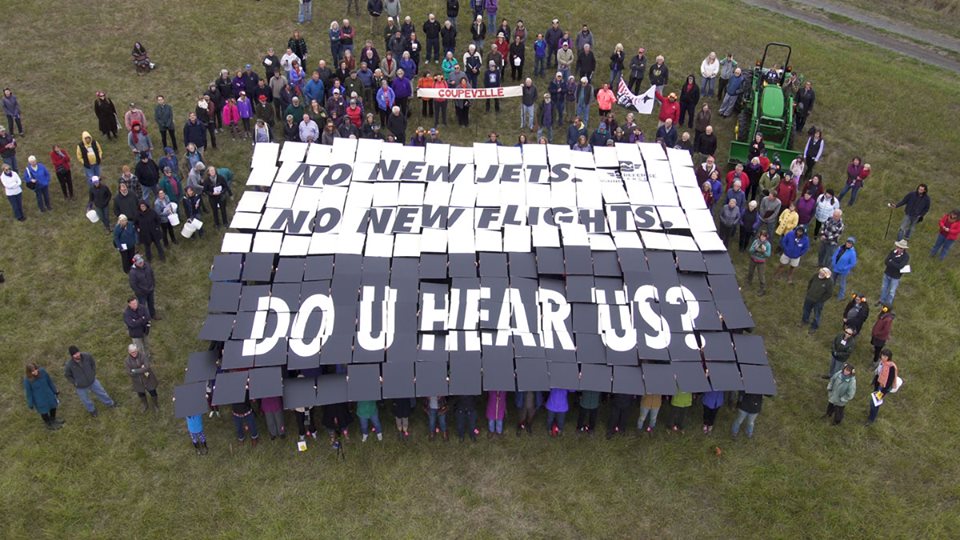
COER has been battling the Navy’s flight expansions by alerted the community about the Navy’s EIS for the Growler jets, which indicated a Finding of No Significant Impact (FONSI). COER requested a new EIS be conducted, hired JGL Acoustics to conduct noise test of the Growler jets, and filed a lawsuit that halted the Navy’s flight paths for about six months. The group rejected the Navy’s expansion request, filed a preliminary injunction to stop training flights until a proper EIS was completed, alerted the community to water contamination caused by the Navy (See Water Contamination on Whidbey Island) (COER).
Island resident Claire Pickard wrote a Letter to the Editor of the Whidbey News Times about the Japanese government planning to purchase an uninhabited island for $150 millions dollars to relocate U.S. military jet training because of complaints from its citizens.”It is time that our leaders acknowledge that military training and civilians do not mix. The Navy’s Growler expansion on Whidbey Island is ill-advised and unsustainable. Central Whidbey residents have been protesting jet noise for decades. Up until now no one has been listening to us. The Japanese government is acting to protect its citizens. Does the Japanese government really care more about its citizens than our government does about ours?”(Pickard 2019).
COER member Cate Andrews “sees the naval jet noise crisis as a ‘moral issue,’ as well as a public health issue. Yet, when she and other COER members have requested meetings with the Navy to share their health-threatening experiences, they’ve been snubbed. ‘The Navy has never responded to any of our requests for meetings…We’ve sent many registered letters, phone calls, emails and faxes asking for a meeting. Suffice it to say that five years of asking local Navy Base Commanders has resulted in nothing’” (Jamail 2017).
The Navy

Flight operations notification for the NASWI complex is updated almost weekly with the flight schedules for Ault Field and OLF Coupeville. The Commander, Navy Installations Command (CNIC) stated that “People living in local communities should remain aware that the aforementioned operations are not the only operations out of NAS Whidbey Island, particularly at Ault Field, which is a 24-hour-a-day operational facility. There are many other training evolution that people may hear. However, the aircraft carrier flight training operations are types of operations that involve lower altitude flight training in close vicinity to the airfield. Both runways at Ault Field are now open. If OLF Coupeville closes for any reason, Ault Field will become the backup airfield for OLF scheduled operations. The base will make every effort to let the community know if there are additions to published schedules” (CNIC 2019). On the Naval Air Station Whidbey Island website there is a link for noise complaints.
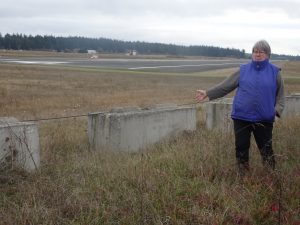
The Navy also gives links to an enhanced Electronic Warfare Training factsheet, a Pacific Northwest environmental projects briefing, frequently asked questions, an informational piece on Electronic Warfare, Environmental Assessment, and a Finding of No Significant Impact (FONSI).

In 2017, The U.S. Environmental Protection Agency (EPA) Office of Environmental Review and Assessment wanted the Navy to reevaluate its Draft Environmental Impact Statement (DEIS). “The DEIS does not contain sufficient information to fully assess the environmental impacts that should be avoided to fully protect the environment and nearby communities.” (Stensland 2017).
The Navy replied that it cannot shift the location of its Field Carrier Landing Practices (FCLP) away from OLF Coupeville, asserting that it “cannot stop training its pilots. Landing on an aircraft carrier is a perishable skill. Stopping training would adversely affect pilot training. Shifting FCLPs to Ault Field interferes with other missions at Ault Field and is also not sustainable. The Navy plans to continue flying FCLPs at OLF Coupeville at the current level until the ongoing EIS is complete. The need for pilots to continue training at OLF Coupeville remains and is independent of any decisions regarding future squadrons. OLF Coupeville is designed to simulate the experience of landing on a carrier, and is critical to the training of our Navy pilots for aircraft carrier operations.” (CNIC n.d.).
Captain Scott Farr, Commodore of the Electronic Attack Wing at NASWI, said “Our aircrew are not looking for a needle in a haystack, they are looking for needle in a pile of needles and have to be very highly trained and proficient to be able to pick out the correct one and employ their systems against them” (Homeport 2016).
Conclusion
In December 2018, the Navy terminated consultation with Washington State Historic Preservation Office (SHPO), and other consulting parties because it failed to reach an agreement on the indirect impacts of increasing flight operations over Whidbey Island.
In March 2019, Navy Secretary Richard Spencer denied a request for further noise monitoring efforts from the federal Advisory Council on Historic Preservation. The Navy will fund a preservation project at Ebey’s Reserve in the amount of $876,000 but does not have the legal authority to pay for residential sound insulation for private homes, as was requested in the letter from the advisory council (Bernton 2019a).
At the same time, the Navy announced its final decision to add 36 Growler aircraft to NASWI, and direct 80 percent of the field carrier landing practice to OLF Coupeville (Stensland 2019). COER, SDA, and other opposing groups vowed to fight the decision.
In July 2019, Washington Attorney General Bob Ferguson announced his office would be joining a lawsuit filed by COER against the Navy’s Growler expansion, because the “Navy environmental review of the expansion unlawfully failed to fully measure the impacts to public health, as well as bald eagles, tufted puffins and other wildlife that, due to the noise, might have feeding and breeding disrupted.” Ferguson stated that Navy’s training needs do “not relieve the federal government of its obligation to follow the law and avoid unnecessary harm to our health and natural resources” (Bernton 2019b).
In September 2019, Whidbey Island landowners sued the Navy, in a lawsuit that “seeks compensation for what they say is their inability to use their property” (Johnson 2019).
The Navy could solve this problem by conducting FCLPs on a retired aircraft carrier anchored offshore or by building/renovating another OLF in a relatively uninhabited area, although that would not remove the negative impacts on the wildlife and environment. Both these options would cost the Navy a substantial amount of money to put into action but would save the citizens surrounding the Growler jet flight path from the effects of noise pollution, lower the chance of a plane crash, and minimize further pollution.
The U.S. military feels it has to conduct the Growler Jet FCLP training to maintain tactical advantage over its adversaries, but does it have to be at the expense of the citizens of Whidbey Island and surrounding areas?
Sources
Bernton, Hal. (2019a, March 11). Navy rejects call for more monitoring of Growler jet training on Whidbey Island. Seattle Times.
Bernton, Hal. (2019b, July 9). Washington state sues Navy over expansion of Growler jet training on Whidbey Island. Seattle Times.
Boeing Co. (n.d.). Overview. Boeing.
Boeing Co. (2008, June 4). Boeing Delivers 1st Fleet EA-18G Growler. Boeing.
Boeing Co. (2008, June 4). Navy Welcomes New Era of Electronic Warfare. DefenseAerospace.
Christensen, Ken. & Ahearn, Ashley. (2016, December. 2). Growler Jets Test Rainforest Peace As NW Military Presence Grows. EarthFix / Oregon Public Broadcasting.
Citizens of Ebey’s Reserve. (2019). Citizens of Ebey’s Reserve.
Commander, Navy Installations Command (CNIC). (n.d.) Growler Fact. CNIC, Naval Air Station Whidbey Island.
Commander, Navy Installations Command (CNIC). (2019, March 1). Flight Operations Notification for NAS Whidbey Island Complex. CNIC, Naval Air Station Whidbey Island.
Homeport Northwest. (2016, September 23). PACFLT EW Training Video Rev FINAL 2016 08 30. YouTube.
Jamail, Dahr. (2015, July 27). Sounds of War: Navy Warplanes Producing Deadly Noise Around US Bases. Truthout.
Jamail, Dahr. (2017, February 6). How much noise can a person survive? Navy jets plague the lives of Washington residents. Truthout.
Johnson, Gene. (2019, September 16). Whidbey Island residents sue over expansion of Navy training flights. Associated Press.
National Park Service. (2019). Ebey’s Landing National Historic Reserve (NHR).
Naval Technology. (n.d.) EA-18G Growler Electronic Attack Aircraft, Naval Technology.
Navy Safety Center.(2015, September 17). Aircraft Noise 101: Introduction to Noise Science and Modeling. YouTube.
Pickard, Claire. (2019, January 18). Japanese Understand Impact of Navy jet noise. Whidbey News Times.
Sound Defense Alliance (SDA). (2019). Purpose. South Defense Alliance.
Stensland, Jessie. (2017, March 28). Federal agencies weigh in on Growler impacts; National Park Service offers to acquire OLF Coupeville. Whidbey News-Times.
Stensland, Jessie. (2019, March 14). Navy announces decision on Growlers. Whidbey News-Times.
Trevithick, Joseph. (2018, February 23). Freezing Navy EA-18G Crew In Ice Filled Cockpit Navigated Home Using Their Smart Watches. The Drive.
Wilkinson, Eric. (2018, June 26). NAS Whidbey Proposal For More Noisy Jet Flights Rattles Neighbors. YouTube.
